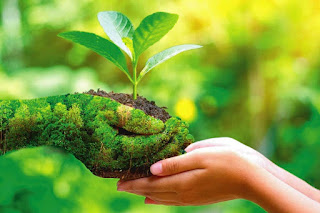LIVING IN HARMONY WITH NATURE IS THE KEY TO OUR SUSTAINABLE FUTURE
Our environment is a complex dynamic system that includes both living and non-living components of the biosphere with a constant exchange of materials and energy among them . While we consume many useful things from the environment like air, water, and food we also try to replenish some materials in the form of new plantations, carbon dioxide by our breath etc. Over a large period of time, an equilibrium is established among the various components of the environment allowing life to flourish. A key requirement for life to flourish on the Earth is the prevailing of a moderate range of temperature in which water, the prime necessity for life, exists in all its three different forms.
However, it is a matter of great concern that since the industrial revolution of the 18th century, our contribution to the environment has been minuscule compared to the vast benefits that we have enjoyed. Further, man's interference with nature has resulted in an irreversible change of the ecological balance that formed the very basis of our survival on the planet. One of the prime problems threatening our survival today is the temperature rise called global warming and the climate change phenomenon arising out of it. The main cause for global warming is the increase of certain greenhouse gases in our atmosphere like carbon dioxide primarily due to man-made emissions.
. The combustion of fossil fuels in industries and automobiles, in particular, has resulted in huge emissions of carbon dioxide gas into our atmosphere. According to a report, Earth's average temperature has risen by 1 0C since pre-industrial times and the temperature is steadily rising at a rate of 0.20C per decade. Although this is not very alarming from the figure point of view, this has a significant effect over our delicate ecological balance.
The natural presence of carbon dioxide in our atmosphere is very small, nearly 0.03%. Traces of greenhouse gases like carbon dioxide, to some extent, are desirable for life. This is because they trap the Sun's radiant heat producing a minimum temperature for life to exist . Without them, the average temperature of our Earth would have dropped to -25 0C instead of 140C where no life could exist. However, due to excess emissions of these gases from hectic industrial activities of recent times , the global temperature has taken an upward trend making conditions unsuitable for life. According to a report published in 2019, the two main greenhouse gases, namely carbon dioxide and methane, have increased by 48% and 160% respectively since the pre-industrial times in our atmosphere.
The thick tropical rainforest on the basin of the river Amazon used to absorb most of the carbon dioxide from the atmosphere leveraging the greenhouse effect and, hence, called the Lungs of the Planet. However, the forest is now fast dwindling because of man's burning and cutting down of trees. According to a report, the forest is shrinking at an alarming rate of 2,00,000 hectares annually and 150 acres per minute. A total of 20% of this precious jungle has already vanished and if the trend continues the days are not very far when the entire jungle will be wiped out.
One of the direct consequences of global warming is climate change. Monsoons, crucial to our agriculture, are now turning untimely. Fertile agricultural fields which were once abounding with green vegetation have now gone parched due to the shortfall of rains. Summer time temperature in some parts of India is inching towards 500C while winters have become extremely frigid with mercury plummeting below 00C in some parts of the country. Frequency of tropical cyclones have increased as they continue to visit coastal areas one after the other wreaking havoc. Rivers have gone dry and lack any potential for sustaining agriculture. Ground water level, which is the major source of water for people now , is constantly declining due to excessive pressure. Climate related disasters like floods, famines, cyclones and forest fires have been frequent. Climate change has also affected the livelihoods of people. Local people who used to depend on forest products as the means of their subsistence will bear the brunt because of the destruction of forests. Acidification of sea water has resulted in the destruction of coral reefs which are the main breeding grounds of fishes affecting the fishery industry all over the world. Climate change has also affected many other sectors of the economy like tourism, insurance, health and entertainment all over the world. The most vulnerable sections to climate change are, however, the people of developing and under-developed countries of Africa, Asia and Latin America, with women and children forming the bulk of the victims, as they lack necessary finance and technology to combat the wrath of climate change.
Hence, climate change has affected people and places worldwide. What is the way out? We have to minimize the use of fossil fuels and explore alternative and green sources of energy like solar, wind and geothermal. In personal life, energy saving techniques and eco-friendly practices should be cultivated . We should prefer bicycles to go over short distances rather than bikes that spew emissions. Mass transport vehicles like city buses should be used for commuting between fixed destinations within a city to save fuel. Use of polythene bags should be avoided so as to preserve the quality of the soil. We should refrain ourselves from interference with nature in all our activities and learn how to live in complete harmony with it. To remind us of all these facts and our commitments to safeguard our fragile environment and the basic life support system of our planet , June 5 is celebrated as the World Environment Day every year .
Education Officer,
Regional Science Centre,
Bhopal




Comments
Post a Comment